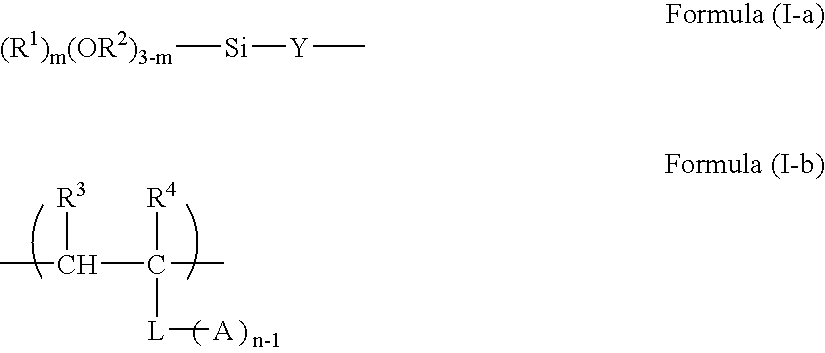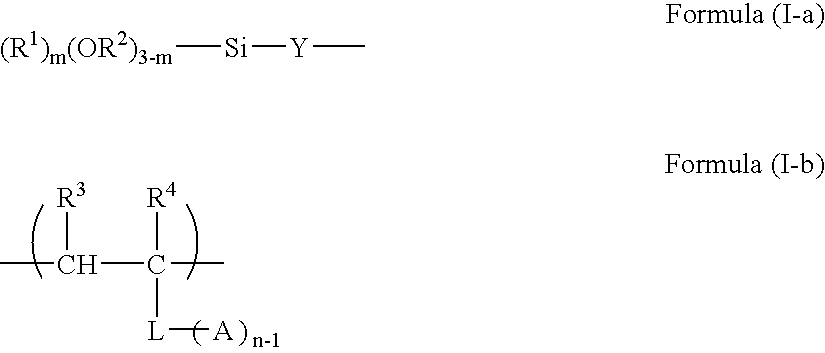Hydrophilic composition and hydrophilic member
- Summary
- Abstract
- Description
- Claims
- Application Information
AI Technical Summary
Benefits of technology
Problems solved by technology
Method used
Image
Examples
synthesis example 1
Synthesis of Specified Hydrophilic Polymer (1-1)
1. Synthesis of Hydrophilic Polymer (1)
[0116] 50 g of acrylamide, 1.8 g of 3-mercaptopropionic acid, and 220 g of dimethyl sulfoxide were charged in a 500 ml three-necked flask and, in a nitrogen stream at 65° C., 0.5 g of dimethyl 2,2′-azobis(2-methyl propionate) was added. After being kept at that temperature while being stirred for 6 hours, the mixture was cooled to room temperature. This was poured into 2 litters of methanol,and precipitated solids were separated by filtration and washed with acetone to obtain a hydrophilic polymer (1) having the following structure in which the polymerization degree n of the repetitive units of the polymer chain was about 46. Weight after drying was 50.4 g. The polymer had a weight average molecular weight of 3,400 based on GPC (polyethylene oxide standard).
2. (A) Synthesis of Specified Hydrophilic Polymer (1-1)
[0117] 30 g of the hydrophilic polymer (1) obtained in the Synthesis Example 1, ...
synthesis example 2
(A) Synthesis of Specified Hydrophilic Polymer (1-2)
[0118] 30 g of the hydrophilic polymer (1) obtained in the Synthesis Example 1, 2.05 g of 3-triethoxysilyl propyl isocyanate, and 150 g of distilled water were charged into a 300 ml three-necked flask and stirred at a room temperature for 2 hours. The mixture was poured into 1.5 liters of methanol, and precipitated solids were separated by filtration and washed with acetone to obtain a specified hydrophilic polymer (1-2) having the following structure. It was confirmed by 1H-NMR that a triethoxy silyl group (Si—OCH2CH3: 3.5 ppm) was introduced into the terminal end.
synthesis example 3
(A) Synthesis of Specified Hydrophilic Polymer (2-1)
1. Synthesis of Hydrophilic Polymer (2)
[0119] 50 g of potassium 2-sulfoethyl acrylate salt, 0.65 g of 2-aminoethane thiol hydrochloride, and 220 g of distilled water were charged in a 500 ml three-necked flask and, in a nitrogen stream at 50° C., 0.22 g of 2,2′-azobis[2-(2-imidazolin-2-yl)propane] dihydrochloride was added. After being kept at that temperature while being stirred for 6 hours, the mixture was cooled to room temperature. This was poured into 2 litters of dimethyl sulfoxide, precipitated solids were separated by filtration and washed with acetone to obtain a hydrophilic polymer (2) having the following structure in which the polymerization degree n of the repetitive units of the polymer chain was about 35. Weight after drying was 47.6 g. The polymer had a weight average molecular weight of 7,700 based on GPC (polyethylene oxide standard).
2. (A) Synthesis of Specified Hydrophilic Polymer (2-1)
[0120] 30 g of the ...
PUM
| Property | Measurement | Unit |
|---|---|---|
| Percent by mass | aaaaa | aaaaa |
| Percent by mass | aaaaa | aaaaa |
| Molecular weight | aaaaa | aaaaa |
Abstract
Description
Claims
Application Information
 Login to View More
Login to View More - R&D
- Intellectual Property
- Life Sciences
- Materials
- Tech Scout
- Unparalleled Data Quality
- Higher Quality Content
- 60% Fewer Hallucinations
Browse by: Latest US Patents, China's latest patents, Technical Efficacy Thesaurus, Application Domain, Technology Topic, Popular Technical Reports.
© 2025 PatSnap. All rights reserved.Legal|Privacy policy|Modern Slavery Act Transparency Statement|Sitemap|About US| Contact US: help@patsnap.com



